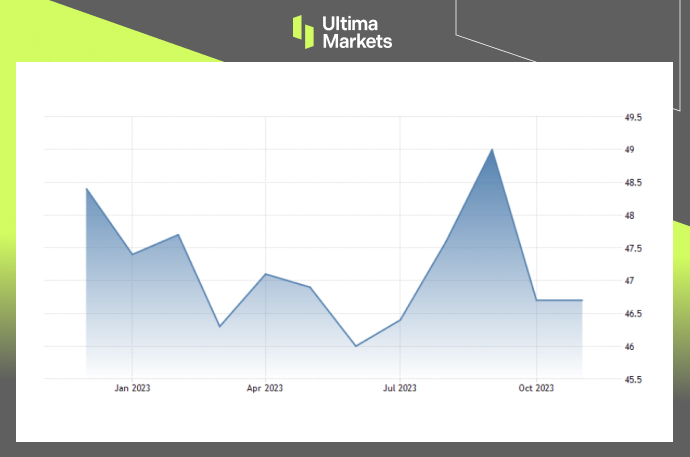You are visiting the website that is operated by Ultima Markets Ltd, a licensed investment firm by the Financial Services Commission “FSC” of Mauritius, under license number GB 23201593. Please be advised that Ultima Markets Ltd does not have legal entities in the European Union.
If you wish to open an account in an EU investment firm and protected by EU laws, you will be redirected to Ultima Markets Cyprus Ltd (the “CIF”), a Cyprus investment firm duly licensed and regulated by the Cyprus Securities and Exchange Commission with license number 426/23.

ISM Manufacturing PMI Falls Short of Expectations
In November 2023, the Institute of Supply Management (ISM) Manufacturing Purchasing Managers Index (PMI) maintained its position at 46.7, mirroring the October reading and falling short of economists’ expectations set at 47.6. This steady figure underscores the persistent challenges faced by the manufacturing sector, signaling ongoing contractionary pressures.

(Purchasing Managers Index PMI,ISM)
ISM Manufacturing PMI Key Metrics Overview
Production Index: A Deteriorating Landscape
The production index, a crucial indicator of manufacturing health, witnessed a decline into contractionary territory at 48.5, down from October’s 50.4. This downturn suggests a concerning shift in the manufacturing landscape, with implications for overall economic activity.
Employment Index: Quickening Job Losses
The employment index dipped to 45.8 from 46.8 in the preceding month, indicating an acceleration in job losses within the manufacturing sector. This trend is a critical factor affecting both the industry and the broader labor market.
Supplier Deliveries Index: Prolonged Contraction
The Supplier Deliveries Index slid for the 14th consecutive month to 46.2 from 47.7, portraying an environment where deliveries from suppliers are accelerating as demand weakens. This ongoing contraction underscores challenges in the supply chain.
New Orders and Inventories: Contractions with a Silver Lining
While new orders and inventories remained in contraction, there is a glimmer of positivity. New orders increased to 48.3 in November from 45.5 in October, and inventories rose to 44.8 from 43.3. This slower pace of decline suggests a potential stabilization in demand.
Prices Paid Index: Moderation Amidst Volatility
The prices paid index experienced a moderate uptick to 49.9 from 45.1, indicating some moderation and stability in manufacturing input prices. This is attributed to easing energy markets, although challenges persist due to rising steel prices.
Forward-Looking Insights
Manufacturing lead times continue to compress, signaling potential improvements in future conditions. Shorter lead times generally indicate enhanced efficiency in securing inputs and delivering finished products.
However, despite these positive indicators, the manufacturing sector remains entrenched in a significant downturn, as highlighted by the latest PMI data.
ISM Manufacturing PMI Future Outlook
The duration of these challenging conditions hinges on global demand stabilization and the trajectory of energy and commodity prices.
The manufacturing sector’s revival is contingent on broader economic factors, emphasizing the interconnectedness of global markets.
Frequently Asked Questions
Q1: What does the ISM Manufacturing PMI measure?
A1: The ISM Manufacturing PMI is a key economic indicator that gauges the health of the manufacturing sector based on factors such as production, employment, supplier deliveries, new orders, inventories, and prices paid.
Q2: Why is the November 2023 PMI figure significant?
A2: The November 2023 PMI figure of 46.7 is crucial as it indicates the persistent challenges and contractionary pressures faced by the manufacturing sector, reflecting on the overall economic landscape.
Q3: What factors contribute to the manufacturing sector’s downturn?
A3: Factors include declining production, accelerated job losses, prolonged contraction in supplier deliveries, and challenges in managing input prices amidst volatile energy and commodity markets.
Bottom Line
In conclusion, the November 2023 ISM Manufacturing PMI report provides a detailed snapshot of the challenges and nuances within the sector.
The intricate analysis of key metrics offers valuable insights for industry stakeholders and policymakers alike as they navigate the complex landscape of manufacturing in the United States.
Vì sao chọn giao dịch Kim loại & Hàng hóa với Ultima Markets?
Ultima Markets cung cấp điều kiện giao dịch và chi phí cạnh tranh hàng đầu cho các mặt hàng phổ biến trên toàn thế giới.
Bắt đầu giao dịchTheo dõi thị trường mọi lúc mọi nơi
Thị trường dễ bị ảnh hưởng bởi những thay đổi về cung và cầu
Hấp dẫn với các nhà đầu tư chỉ quan tâm đến đầu cơ giá
Thanh khoản sâu và đa dạng, không có phí ẩn
Không qua môi giới tạo lập thị trương, không báo giá lại
Khớp lệnh nhanh chóng thông qua máy chủ Equinix NY4














